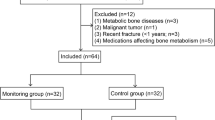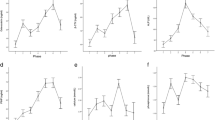Abstract
Introduction
Bone turnover markers (BTMs) can be used to monitor bone metabolism, while the actual clinical changing in hip fracture had not been certified to evaluate the changes of BTMs during the healing process after surgery of elderly hip fractures; and to get the effects of operation type, gender, serum 25(OH)D level, and age on bone turnover markers.
Materials and methods
A total of 100 elderly cases with hip fracture were selected, including 74 females and 26 males, and the patients were followed to 180–230 days after surgery. Serum levels of N-propeptide of type 1 collagen (P1NP), C-terminal crosslinking telopeptides of type 1 collagen (CTX), Osteocalcin (OC), and 25 hydroxy vitamin D (25OHD) were investigated. Bone mineral density (BMD) was measured with dual-energy X-ray absorptiometry (DXA).
Results
(1) P1NP and CTX showed peak time at 30–60 days after operation, while OC keep going even at 180–230 days; P1NP showed less than 4 times elevation during healing, CTX and OC only had less than 2 times rise. (2) Female had higher serum CTX and OC than male, intramedullary nailing for intertrochanteric fracture patients had higher P1NP than hip replacement for femoral neck fracture patients, and both the degrees of increase were less than 50%. (3) Serum average 25(OH)D level had no effect on BTMs during the fracture healing; different from the young old (65–84 years), serum OC level of eldest older patients(≥ 85 years) decreased early in the process of fracture healing.
Conclusions
BTMs reached the peak level in 30–60 days after surgery, P1NP showed less than 4 times elevation, and CTX and OC had less than 2 times rise. It was not necessary to take gender into account when observing P1NP, and it was not necessary to take fracture and operation type into account when observing CTX and OC.




Similar content being viewed by others
References
Moghaddam A, Müller U, Roth HJ, Wentzensen A, Grützner PA, Zimmermann G (2011) TRACP 5b and CTX as osteological markers of delayed fracture healing. Inj Int J Care Inj 42:758–764
Cunningham BP, Brazina S, Morshed S, Miclau T 3rd (2017) Fracture healing: a review of clinical, imaging and laboratory diagnostic options. Injury 48:S69–S75
Sousa Cristina P, Dias Isabel R, Lopez-Peña Mónica, Camassa José A, Lourenço Paulo J, Judas Fernando M, Gomes Manuela E, Reis Rui L (2015) Bone turnover markers for early detection of fracture healing disturbances: a review of the scientific literature. An Acad Bras Cienc 87:1049–1061
Christoph W, Daniela S, Thorsten Gühring, Caner T, Bernd H, Ulrich K, Paul Alfred G, Leila K (2014) Characteristics of bone turnover in the long bone metaphysis fractured patients with normal or low bone mineral density (bmd). PLoS ONE 9:e96058
Mukhopadhyay M, Sinha R, Pal M et al (2011) Role of common biochemical markers for the assessment of fracture union. Indian J Clin Biochem 26:274–278
Ichimura S, Hasegawa M (2009) Biochemical markers of bone turnover new aspect changes in bone turnover markers during fracture healing. Clin Calcium 19:1102–1108
Ikegami S, Kamimura M, Nakagawa H et al (2009) Comparison in bone turnover markers during early healing of femoral neck fracture and trochanteric fracture in elderly patients. Orthop Rev 1:50–55
Genant HK, Cooper C, Poor G et al (1999) Interim report and recommendations of the World Health Organization task-force for osteoporosis. Osteoporos Int 10:259–264
Hoesel LM, Wehr U, Rambeck WA, Schnettler R, Heiss C (2005) Biochemical bone markers are useful to monitor fracture repair. Clin Orthop 440:226–232
Ohishi T, Takahashi M, Kushida K et al (1998) Changes of biochemical markers during fracture healing. Arch Orthop Trauma Surg 118:126–130
Sato Y, Kaji M, Higuchi F et al (2001) Changes in bone and calcium metabolism following hip fracture in elderly patients. Osteoporos Int 12:445–449
Stewart CC, O’Hara NN, Orwig D et al (2019) Serum 25(OH)D is associated with an altered bone turnover marker response after a hip fracture. J Orthop Res 37:535–540
Ivaska KK, Gerdhem P, Akesson K et al (2007) Effect of fracture on bone turnover markers: a longitudinal study comparing marker levels before and after injury in 113 elderly women. J Bone Miner Res 22:1155–1164
Yu-Yahiro Janet A, Michael RH, Dubin NH et al (2001) Serum and urine markers of bone metabolism during the year after hip fracture. J Am Geriatr Soc 49:877–883
Veitch SW, Findlay SC, Hamer AJ et al (2006) Changes in bone mass and bone turnover following tibial shaft fracture. Osteoporos Int 17:364–372
Van Vugt AB, Oosterwijk WM, Goris RJA (1993) Predictive value of early scintimetry in intracapsular hip fractures. A prospective study with regard to femoral head necrosis, delayed union and non-union. Arch Orthop Trauma Surg 113:33–38
Li M, Li Y, Deng W et al (2014) Chinese bone turnover marker study: reference ranges for C-terminal telopeptide of type I collagen and procollagen I N-terminal peptide by age and gender. PLoS ONE 9:e103841
Tian L, Yang R, Wei L et al (2017) Prevalence of osteoporosis and related lifestyle and metabolic factors of postmenopausal women and elderly men: a cross-sectional study in Gansu province, Northwestern of China. Medicine 96:e8294
Bollen AM, Kiyak HA, Eyre DR (1997) Longitudinal evaluation of a bone resorption marker in elderly subjects. Osteoporos Int 7:544–549
Sprague S, Bhandari M, Devji T et al (2016) Prescription of vitamin D to fracture patients: a lack of consensus and evidence[J]. J Orthop Trauma 30:e64–e69
Acknowledgements
Not applicable.
Funding
Fund project supported this work: Beijing Municipal Administration of Hospitals Incubating Program, Code: PX 2019015; Beijing Municipal Health Committee Scientific Research Project, Code: Beijing 19-17.
Author information
Authors and Affiliations
Corresponding author
Ethics declarations
Conflict of interest
No competing interests to declare.
Additional information
Publisher's Note
Springer Nature remains neutral with regard to jurisdictional claims in published maps and institutional affiliations.
About this article
Cite this article
Li, Xp., Li, Xy., Yang, Mh. et al. Changes of bone turnover markers after elderly hip fracture surgery. J Bone Miner Metab 39, 237–244 (2021). https://doi.org/10.1007/s00774-020-01140-y
Received:
Accepted:
Published:
Issue Date:
DOI: https://doi.org/10.1007/s00774-020-01140-y




